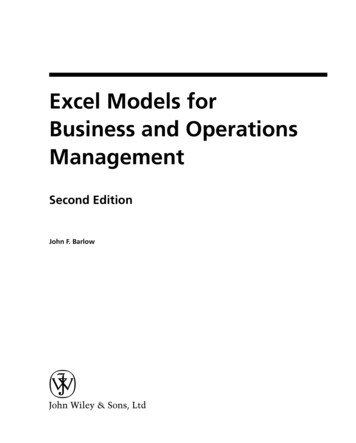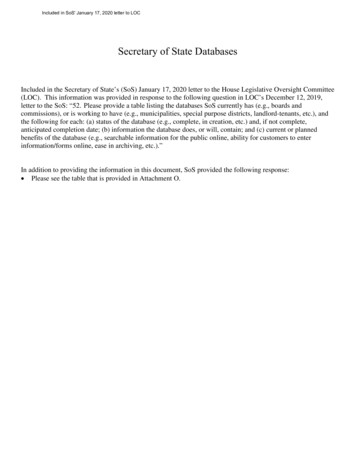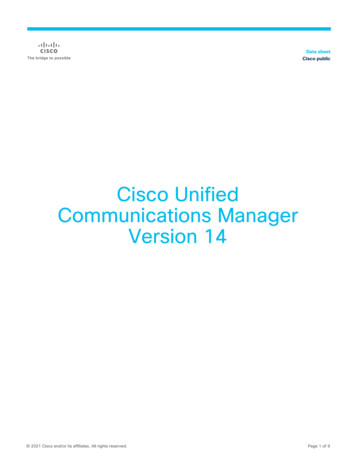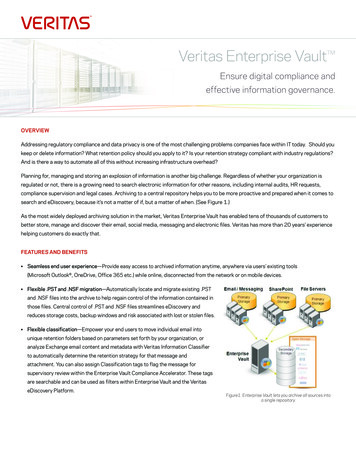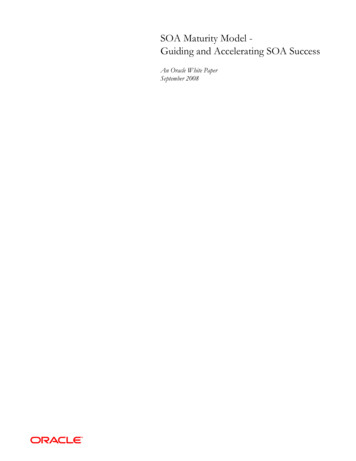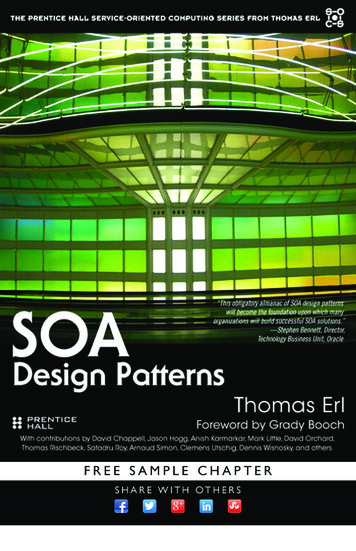
Transcription
Agnostic Capability (324) How can multipurpose service logic be made effectivelyconsumable and composable?Compatible Change (465)How can a service contract be modifiedwithout impacting consumers?Agnostic Context (312) How can multipurpose service logic be positioned as aneffective enterprise resource?Compensating Service Transaction (631)How can composition runtime exceptions beconsistently accommodated without requiringservices to lock resources?Agnostic Sub-Controller (607) How canagnostic, cross-entity composition logic beseparated, reused, and governed independently?Asynchronous Queuing (582) How can aservice and its consumers accommodateisolated failures and avoid unnecessarily lockingresources?Atomic Service Transaction (623) How cana transaction with rollback capability bepropagated across messaging-based services?Brokered Authentication (661) How can aservice efficiently verify consumer credentials ifthe consumer and service do not trust eachother or if the consumer requires access tomultiple services?Canonical Expression (275) How canservice contracts be consistently understoodand interpreted?Canonical Protocol (150) How can servicesbe designed to avoid protcol bridging?Canonical Resources (237) How canunnecessary infrastructure resource disparitybe avoided?Canonical Schema (158) How canservices be designed to avoid data modeltransformation?Composition Autonomy (616) How cancompositions be implemented to minimize lossof autonomy?Concurrent Contracts (421) How can aservice facilitate multi-consumer couplingrequirements and abstraction concerns at thesame time?Contract Centralization (409) How candirect consumer-to-implementation couplingbe avoided?Contract Denormalization (414) How can aservice contract facilitate consumer programswith differing data exchange requirements?Cross-Domain Utility Layer (267) How canredundant utility logic be avoided acrossdomain service inventories?Data Confidentiality (641) How can datawithin a message be protected so that it is notdisclosed to unintended recipients while intransit?Data Format Transformation (681)How can services interact with programs thatcommunicate with different data formats?Data Model Transformation (671) How canservices interoperate when using different datamodels for the same type of data?Canonical Schema Bus (709)Canonical Versioning (286) How can servicecontracts within the same service inventory beversioned with minimal impact?Data Origin Authentication (649) How cana service verify that a message originates from aknown sender and that the message has notbeen tampered with in transit?Capability Composition (521) How can aservice capability solve a problem that requireslogic outside of the service boundary?Decomposed Capability (504) How can aservice be designed to minimize the chances ofcapability logic deconstruction?Capability Recomposition (526)How can the same capability be used to helpsolve multiple problems?Decoupled Contract (401) How can a serviceexpress its capabilities independently of itsimplementation?(pattern list continued on inside back cover)
Praise for this Book“With the continued explosion of services and the increased rate of adoption of SOA throughthe market, there is a critical need for comprehensive, actionable guidance that provides thefastest possible time to results. Microsoft is honored to contribute to the SOA Design Patternsbook, and to continue working with the community to realize the value of Real World SOA.”- Steven Martin, Senior Director, Developer Platform Product Management, Microsoft“SOA Design Patterns provides the proper guidance with the right level of abstraction to beadapted to each organization’s needs, and Oracle is pleased to have contributed to the patternscontained in this book.”- Dr. Mohamad Afshar, Director of Product Management, Oracle Fusion Middleware, Oracle“Red Hat is pleased to be involved in the SOA Design Patterns book and contribute importantSOA design patterns to the community that we and our customers have used within our ownSOA platforms. I am sure this will be a great resource for future SOA practitioners.”- Pierre Fricke Director, Product Line Management, JBoss SOA Platform, Red Hat“A wealth of proven, reusable SOA design patterns, clearly explained and illustrated with examples. An invaluable resource for all those involved in the design of service-oriented solutions.”- Phil Thomas, Consulting IT Specialist, IBM Software Group“This obligatory almanac of SOA design patterns will become the foundation on which manyorganizations will build their successful SOA solutions. It will allow organizations to build theirown focused SOA design patterns catalog in an expedited fashion knowing that it contains thewealth and expertise of proven SOA best practices.”- Stephen Bennett, Director, Technology Business Unit, Oracle Corporation“The technical differences between service orientation and object orientation are subtleenough to confuse even the most advanced developers. Thomas Erl’s book provides a greatservice by clearly articulating SOA design patterns and differentiating them from similar OOdesign patterns.”- Anne Thomas Manes, VP & Research Director, Burton Group“SOA Design Patterns does an excellent job of laying out and discussing the areas of SOA designthat a competent SOA practitioner should understand and employ.”- Robert Laird, SOA Architect, IBM
“As always, Thomas delivers again. In a well-structured and easy-to-understand way, this bookprovides a wonderful collection of patterns each addressing a typical set of SOA design problems with well articulated solutions. The plain language and hundreds of diagrams included inthe book help make the complicated subjects of SOA design comprehensible even to thosewho are new to the SOA design world. It’s a must-have reference book for all SOA practitioners, especially for enterprise architects, solution architects, developers, managers, and businessprocess experts.”- Canyang Kevin Liu, Solution Architecture Manager, SAP“The concept of service oriented architecture has long promised visions of agile organizationsbeing able to swap out interfaces and applications as business needs change. SOA also promises incredible developer and IT productivity, with the idea that key services would be candidates for cross-enterprise sharing or reuse. But many organizations’ efforts to move to SOAhave been mired—by organizational issues, by conflicting vendor messages, and by architectures that may amount to little more than Just a Bunch of Web Services. There’s been a lot ofconfusion in the SOA marketplace about exactly what SOA is, what it’s supposed to accomplish, and how an enterprise goes about in making it work.SOA Design Patterns is a definitive work that offers clarity on the purpose and functioning ofservice oriented architecture. SOA Design Patterns not only helps the IT practitioner lay thegroundwork for a well-functioning SOA effort across the enterprise, but also connects the dotsbetween SOA and the business requirements in a very concrete way. Plus, this book is completely technology agnostic–SOA Design Patterns rightly focuses on infrastructure and architecture, and it doesn’t matter whether you’re using components of one kind or another, or Java,or .NET, or Web services, or REST-style interfaces.While no two SOA implementations are alike, Thomas Erl and his team of contributors haveeffectively identified the similarities in composition services need to have at a sub-atomic levelin order to interact with each other as we hope they will. The book identifies 85 SOA designpatterns which have been developed and thoroughly vetted to ensure that a service-orientedarchitecture does achieve the flexibility and loose coupling promised. The book is also compelling in that it is a living document, if you will, inviting participation in an open process toidentify and formulate new patterns to this growing body of knowledge.”- Joe McKendrick, Independent Analyst, Author of ZDNet’s SOA Blog“If you want to truly educate yourself on SOA, read this book.”- Sona Srinivasan, Global Client Services & Operations, CISCO“An impressive decomposition of the process and architectural elements that support serviceoriented analysis, design, and delivery. Right-sized and terminologically consistent.Overall, the book represents a patient separation of concerns in respect of the process andarchitectural parts that underpin any serious SOA undertaking. Two things stand out. First, thepattern relationship diagrams provide rich views into the systemic relationships that structurea service-oriented architecture: these patterns are not discrete, isolated templates to be applied
mechanically to the problem space; rather, they form a network of forces and constraints thatguide the practitioner to consider the task at hand in the context of its inter-dependencies. Second, the pattern sequence diagrams and accompanying notes provide a useful framework forplanning and executing the many activities that comprise an SOA engagement.”- Ian Robinson, Principal Technology Consultant, ThoughtWorks“Successful implementation of SOA principles requires a shift in focus from software systemmeans, or the way capabilities are developed, to the desired end results, or real-world effectsrequired to satisfy organizational business processes. In SOA Design Patterns, Thomas Erl provides service architects with a broad palette of reusable service patterns that describe servicecapabilities that can cut across many SOA applications. Service architects taking advantage ofthese patterns will save a great deal of time describing and assembling services to deliver the realworld effects they need to meet their organization’s specific business objectives.”- Chuck Georgo, Public Safety and National Security Architect“In IT, we have increasingly come to see the value of having catalogs of good solution patternsin programming and systems design. With this book, Thomas Erl brings a comprehensive setof patterns to bear on the world of SOA. These patterns enable easily communicated, reusable,and effective solutions, allowing us to more rapidly design and build out the large, complicatedand interoperable enterprise SOAs into which our IT environments are evolving.”- Al Gough, Business Systems Solutions CTO, CACI International Inc.“This book provides a comprehensive and pragmatic review of design issues in service-centricdesign, development, and evolution. The Web site related to this book [SOAPatterns.org] is awonderful platform and gives the opportunity for the software community to maintain this catalogue .”- Veronica Gacitua Decar, Dublin City University“Erl’s SOA Design Patterns is for the IT decision maker determined to make smart architecturedesign choices, smart investments, and long term enterprise impact. For those IT professionalscommitted to service-orientation as a value-added design and implementation option, Patternsoffers a credible, repeatable approach to engineering an adaptable business enterprise. This isa must read for all IT architect professionals.”- Larry Gloss, VP and General Manager, Information Manufacturing, LLC“These SOA patterns define, encompass, and comprise a complete repertoire of best practicesfor developing a world-class IT SOA portfolio for the enterprise and its organizational unitsthrough to service and schema analysis and design. After many years as an architect on manySOA projects, I strongly recommend this book be on the shelf of every analyst and technicalmember of any SOA effort, right next to the SOA standards and guidelines it outlines andelucidates the need for. Our SOA governance standards draw heavily from this work and others from this series.”- Robert John Hathaway III, Enterprise Software Architect, SOA Object Systems
“A wise man once told me that wisdom isn’t all about knowledge and intelligence, it is just asmuch about asking questions. Asking questions is the true mark of wisdom and during the writing of the SOA Design Patterns book Thomas Erl has shown his real qualities. The communityeffort behind this book is huge meaning that Thomas has had access to the knowledge andexperience of a large group of accomplished practitioners. The result speaks for itself. Thisbook is packed with proven solutions to recurring problems, and the documented pros andcons of each solution have been verified by persons with true experience. This book could giveSOA initiatives of any scale a real boost.”- Herbjörn Wilhelmsen, Architect and Senior Consultant, Objectware“This book is an absolute milestone in SOA literature. For the first time we are provided with apractical guide on how the principle centric description of service orientation from a vendoragnostic viewpoint is actually made to work in a language based on patterns. This book makesyou talk SOA! There are very few who understand SOA like Thomas Erl does, he actually put’sit all together!”- Brian Lokhorst, Solution Architect, Dutch Tax Office“Service oriented architecture is all about best practices we have learned since IT’s existence.This book takes all those best practices and bundles them into a nice pattern catalogue. [It provides] a really excellent approach as patterns are not just documented but are provided withapplication scenarios through case studies [which] fills the gap between theory and practice.”- Shakti Sharma, Senior Enterprise Architect, Sysco Corp“An excellent and important book on solving problems in SOA [with a] solid structure. Has thepotential of being among the major influential books.”- Peter Chang, Lawrence Technical University“SOA Design Patterns presents a vast amount of knowledge about how to successfully implement SOA within an organization. The information is clear, concise, and most importantly,legitimate.”- Peter B. Woodhull, President and Principal Architect, Modus21“SOA Design Patterns offers real insights into everyday problems that one will encounter wheninvesting in services oriented architecture. [It] provides a number of problem descriptions andoffers strategies for dealing with these problems. SOA design patterns highlights more than justthe technical problems and solutions. Common organizational issues that can hinder progresstowards achieving SOA migration are explained along with potential approaches for dealingwith these real world challenges. Once again Thomas Erl provides in-depth coverage of SOAterminology and helps the reader better understand and appreciate the complexities of migrating to an SOA environment.”- David Michalowicz, Air and Space Operations Center Modernization Team Lead,MITRE Corporation
“This is a long overdue, serious, comprehensive, and well-presented catalog of SOA design patterns. This will be required reading and reference for all our SOA engineers and architects. Thebest of the series so far![The book] works in two ways: as a primer in SOA design and architecture it can easily be readfront-to-back to get an overview of most of the key design issues you will encounter, and as areference catalog of design techniques that can be referred to again and again ”- Wendell Ocasio, Architecture Consultant, DoD Military Health Systems, Agilex Technologies“Thomas has once again provided the SOA practitioner with a phenomenal collection ofknowledge. This is a reference that I will come back to time and time again as I move forwardin SOA design efforts.What I liked most about this book is its vendor agnostic approach to SOA design patterns. Thisapproach really presents the reader with an understanding of why or why not to implement apattern, group patterns, or use compound patterns rather than giving them a marketing spiel onwhy one implementation of a pattern is better than another (for example, why one ESB is better than another). I think as SOA adoption continues to advance, the ability for architects tounderstand when and why to apply specific patterns will be a driving factor in the overall success and evolution of SOA. Additionally, I believe that this book provides the consumer withthe understanding required to chose which vendor’s SOA products are right for their specificneeds.”- Bryan Brew, SOA Consultant, Booz Allen Hamilton“A must have for every SOA practitioner.”- Richard Van Schelven, Principal Engineer, Ericsson“This book is a long-expected successor to the books on object-oriented design patterns andintegration patterns. It is a great reference book that clearly and thoroughly describes designpatterns for SOA. A great read for architects who are facing the challenge of transforming theirenterprise into a service-oriented enterprise.”- Linda Terlouw, Solution Architect, Ordina“The maturation of Service-Orientation has given the industry time to absorb the best practicesof service development. Thomas Erl has amassed this collective wisdom in SOA Design Patterns, an absolutely indispensible addition to any Service Oriented bookshelf.”- Kevin P. Davis, Ph.D“The problem with most texts on SOA is one of specificity. Architects responsible for SOAimplementation in most organizations have little time for abstract theories on the subject, butare hungry for concrete details that they can relate to the real problems they face in their environment. SOA Design Patterns is critical reading for anyone with service design responsibilities.Not only does the text provide the normal pattern templates, but each pattern is applied in
detail against a background case study to provide exceptionally meaningful context to the information. The graphic visualizations of the problems and pattern solutions are excellent supplementary companions to the explanatory text. This book will greatly stretch the knowledge ofthe reader as much for raising and addressing issues that may have never occurred to the readeras it does in treating those problems that are in more common occurrence. The real beauty ofthis book is in its plain English prose. Unlike so many technical reference books, one does notfind themselves re-reading sections multiple times trying to discern the intent of the author.This is also not a reference that will sit gathering dust on a shelf after one or two perusings. Practitioners will find themselves returning over and over to utilize the knowledge in their projects.This is as close as you’ll come to having a service design expert sitting over your shoulder.”- James Kinneavy, Principal Software Architect, University of California“As the industry converges on SOA patterns, Erl provides an outstanding reference guide tocomposition and integration—and yet another distinctive contribution to the SOA practice.”- Steve Birkel, Chief IT Technical Architect, Intel Corp.“With SOA Design Patterns, Thomas Erl adds an indispensable SOA reference volume to thetechnologist’s library. Replete with to-the-point examples, it will be a helpful aid to any ITorganization.”- Ed Dodds, Strategist, Systems Architect, Conmergence“Again, Thomas Erl has written an indispensable guide to SOA. Building on his prior successes,his patterns go into even more detail. Therefore, this book is not only helpful to the SOA beginner, but also provides new insight and ideas to professionals.”- Philipp Offermann, Research Scientist, Technische Universität Berlin, Germany“SOA Design Patterns is an extraordinary contribution to SOA best practices! Once again,Thomas has created an indispensable resource for any person or organization interested in oractively engaged in the practice of Service Oriented Architecture. Using case studies based onthree very different business models, Thomas guides the reader through the process of selecting appropriate implementation patterns to ensure a flexible, well-performing, and secure SOAecosystem.”- Victor Brown, Managing Partner and Principal Consultant,Cypress Management Group Corporation
SOA Design Patterns
The Prentice Hall Service-Oriented Computing Seriesfrom Thomas Erl aims to provide the IT industry witha consistent level of unbiased, practical, andcomprehensive guidance and instruction in the areasof service-oriented architecture, service-orientation,and the expanding landscape that is shapingthe real-world service-oriented computing platform.For more information, visit www.soabooks.com.
SOA Design PatternsThomas Erl(with additional contributors)PRENTICE HALLUPPER SADDLE RIVER, NJ BOSTON INDIANAPOLIS SAN FRANCISCONEW YORK TORONTO MONTREAL LONDON MUNICH PARIS MADRIDCAPETOWN SYDNEY TOKYO SINGAPORE MEXICO CITY
Many of the designations used by manufacturers and sellers to distinguish theirEditor-in-Chiefproducts are claimed as trademarks. Where those designations appear in this book,Mark L. Tauband the publisher was aware of a trademark claim, the designations have beenprinted with initial capital letters or in all capitals.Managing EditorKristy HartThe author and publisher have taken care in the preparation of this book, but makeno expressed or implied warranty of any kind and assume no responsibility forCopy Editorerrors or omissions. No liability is assumed for incidental or consequential damagesLanguage Logisticsin connection with or arising out of the use of the information or programs conIndexertained herein.Cheryl LenserThe publisher offers excellent discounts on this book when ordered in quantity forbulk purchases or special sales, which may include electronic versions and/or cusProofreadertom covers and content particular to your business, training goals, marketing focus,Williams Woodsand branding interests. For more information, please contact:PublishingU.S. Corporate and Government SalesComposition(800) 382-3419Jake McFarlandcorpsales@pearsontechgroup.comBumpy DesignFor sales outside the United States please contact:GraphicsInternational SalesZuzana Cappovainternational@pearson.comTami YoungSpencer FruhlingLibrary of Congress Cataloging-in-Publication Data:Erl, Thomas.PhotosThomas ErlSOA design patterns / Thomas Erl. — 1st ed.Cover Designp. cm.Thomas ErlISBN 0-13-613516-1 (hardback : alk. paper) 1. Web services.2. Computer architecture. 3. Software patterns. 4. System design. I. Title.TK5105.88813.E735 2008006.7—dc222008040488Copyright 2009 SOA Systems Inc.All rights reserved. Printed in the United States of America. This publication is protected by copyright, and permissionmust be obtained from the publisher prior to any prohibited reproduction, storage in a retrieval system, or transmissionin any form or by any means, electronic, mechanical, photocopying, recording, or likewise. For information regardingpermissions, write to:Pearson Education, IncRights and Contracts Department501 Boylston Street, Suite 900Boston, MA 02116Fax (617) 671 3447ISBN-13: 978-0-13-613516-6ISBN-10: 0-13-613516-1Text printed in the United States on recycled paper at R.R. Donnelley in Crawfordsville, Indiana.Fifth Printing: April 2013The following patterns: Exception Shielding, Threat Screening, Trusted Subsystem, Service Perimeter Guard, DataConfidentiality, Data Origin Authentication, Direct Authentication, Brokered Authentication are courtesy of theMicrosoft Patterns & Practices team. For more information please visit http://msdn.microsoft.com/practices.These patterns were originally developed by Jason Hogg, Frederick Chong, Dwayne Taylor, Lonnie Wall, Paul Slater,Tom Hollander, Wojtek Kozaczynski, Don Smith, Larry Brader, Sajjad Nasir Imran, Pablo Cibraro, Nelly Delgado andWard Cunningham
To the SOA pioneers that blazed the trail we now so freely base our roadmaps on, and to the SOAcommunity that helped me refine the wisdom of the pioneers into this catalog of patterns.- Thomas Erl
This page intentionally left blank
ContentsForeword . . . . . . . . . . . . . . . . . . . . . . . . . . . . . . . . xxxviiC HAPTER 1: Introduction . . . . . . . . . . . . . . . . . . . . . . . . . 11.1 Objectives of this Book . . . . . . . . . . . . . . . . . . . . . . . . . . . . . 41.2 Who this Book is For . . . . . . . . . . . . . . . . . . . . . . . . . . . . . . . 41.3 What this Book Does Not Cover . . . . . . . . . . . . . . . . . . . . . . 4Topics Covered by Other Books . . . . . . . . . . . . . . . . . . . . . . . . . . . 4Web Service and REST Service Design Patterns . . . . . . . . . . . . . . 5SOA Standardization Efforts . . . . . . . . . . . . . . . . . . . . . . . . . . . . . . 51.4 Recommended Reading . . . . . . . . . . . . . . . . . . . . . . . . . . . . 61.5 How this Book is Organized . . . . . . . . . . . . . . . . . . . . . . . . . 7Part I: Fundamentals . . . . . . . . . . . . . . . . . . . . . . . . . . . . . . . . . . . . 8Part II: Service Inventory Design Patterns . . . . . . . . . . . . . . . . . . . 8Part III: Service Design Patterns . . . . . . . . . . . . . . . . . . . . . . . . . . . 8Part IV: Service Composition Design Patterns . . . . . . . . . . . . . . . . 9Part V: Supplemental . . . . . . . . . . . . . . . . . . . . . . . . . . . . . . . . . . . 10Part VI: Appendices . . . . . . . . . . . . . . . . . . . . . . . . . . . . . . . . . . . 101.6 Symbols, Figures, Style Conventions . . . . . . . . . . . . . . . . . 11Symbol Legend . . . . . . . . . . . . . . . . . . . . . . . . . . . . . . . . . . . . . . . 11How Color is Used . . . . . . . . . . . . . . . . . . . . . . . . . . . . . . . . . . . . 11Data Flow and Directionality Conventions. . . . . . . . . . . . . . . . . . . 11Pattern Documentation Conventions. . . . . . . . . . . . . . . . . . . . . . . 111.7 Additional Information . . . . . . . . . . . . . . . . . . . . . . . . . . . . . 11Updates, Errata, and Resources (www.soabooks.com) . . . . . . . . 11Visio Stencil (www.soabooks.com) . . . . . . . . . . . . . . . . . . . . . . . . 12
xivContentsCommunity Patterns Site (www.soapatterns.org) . . . . . . . . . . . . . 12Master Glossary (www.soaglossary.com) . . . . . . . . . . . . . . . . . . . 12Supplementary Posters (www.soaposters.com) . . . . . . . . . . . . . . 12The SOA Magazine (www.soamag.com) . . . . . . . . . . . . . . . . . . . 12Referenced Specifications (www.soaspecs.com). . . . . . . . . . . . . 12Notification Service . . . . . . . . . . . . . . . . . . . . . . . . . . . . . . . . . . . . 13Contact the Author . . . . . . . . . . . . . . . . . . . . . . . . . . . . . . . . . . . . 13C HAPTER 2: Case Study Background . . . . . . . . . . . . . . . 152.1 Case #1 Background: Cutit Saws Ltd. . . . . . . . . . . . . . . . . 17History . . . . . . . . . . . . . . . . . . . . . . . . . . . . . . . . . . . . . . . . . . . . . . 18Technical Infrastructure and Automation Environment . . . . . . . . . 18Business Goals and Obstacles . . . . . . . . . . . . . . . . . . . . . . . . . . . 182.2 Case #2 Background: Alleywood Lumber Company . . . . . 19History . . . . . . . . . . . . . . . . . . . . . . . . . . . . . . . . . . . . . . . . . . . . . . 19Technical Infrastructure and Automation Environment . . . . . . . . . 20Business Goals and Obstacles . . . . . . . . . . . . . . . . . . . . . . . . . . . 202.3 Case #3 Background: Forestry RegulatoryCommission (FRC) . . . . . . . . . . . . . . . . . . . . . . . . . . . . . . . . . . 21History . . . . . . . . . . . . . . . . . . . . . . . . . . . . . . . . . . . . . . . . . . . . . . 21Technical Infrastructure and Automation Environment . . . . . . . . . 21Business Goals and Obstacles . . . . . . . . . . . . . . . . . . . . . . . . . . . 22PART I: FUNDAMENTALSC HAPTER 3: Basic Terms and Concepts . . . . . . . . . . . . . 25Purpose of this Introductory Chapter . . . . . . . . . . . . . . . . . . . . . . 263.1 Architecture Fundamentals . . . . . . . . . . . . . . . . . . . . . . . . . 26A Classic Analogy for Architecture and Infrastructure . . . . . . . . . 27Technology Architecture . . . . . . . . . . . . . . . . . . . . . . . . . . . . . . . . 27Technology Infrastructure . . . . . . . . . . . . . . . . . . . . . . . . . . . . . . . 30Software Program . . . . . . . . . . . . . . . . . . . . . . . . . . . . . . . . . . . . . 32Relationship to Design Framework . . . . . . . . . . . . . . . . . . . . . . . . 33
Contentsxv3.2 Service-Oriented Computing Fundamentals. . . . . . . . . . . . 35Service-Oriented Computing . . . . . . . . . . . . . . . . . . . . . . . . . . . . 35Service-Orientation . . . . . . . . . . . . . . . . . . . . . . . . . . . . . . . . . . . . 36Service-Oriented Architecture (SOA) . . . . . . . . . . . . . . . . . . . . . . 37Service . . . . . . . . . . . . . . . . . . . . . . . . . . . . . . . . . . . . . . . . . . . . . 37Service Capability . . . . . . . . . . . . . . . . . . . . . . . . . . . . . . . . . . . . . 38Service Consumer . . . . . . . . . . . . . . . . . . . . . . . . . . . . . . . . . . . . . 38Service Composition . . . . . . . . . . . . . . . . . . . . . . . . . . . . . . . . . . . 40Service Inventory. . . . . . . . . . . . . . . . . . . . . . . . . . . . . . . . . . . . . . 42Service-Oriented Analysis . . . . . . . . . . . . . . . . . . . . . . . . . . . . . . . 43Service Candidate. . . . . . . . . . . . . . . . . . . . . . . . . . . . . . . . . . . . . 443.3 Service Implementation Mediums. . . . . . . . . . . . . . . . . . . . 44Services as Components . . . . . . . . . . . . . . . . . . . . . . . . . . . . . . . 45Services as Web Services . . . . . . . . . . . . . . . . . . . . . . . . . . . . . . 45REST Services . . . . . . . . . . . . . . . . . . . . . . . . . . . . . . . . . . . . . . . . 46C HAPTER 4: The Architecture of Service-Orientation . . 47Purpose of this Introductory Chapter . . . . . . . . . . . . . . . . . . . . . . 484.1 The Method of Service-Orientation . . . . . . . . . . . . . . . . . . . 48Principles of Service-Orientation . . . . . . . . . . . . . . . . . . . . . . . . . . 48Strategic Goals of Service-Oriented Computing. . . . . . . . . . . . . . 514.2 The Four Characteristics of SOA. . . . . . . . . . . . . . . . . . . . . 52Business-Driven . . . . . . . . . . . . . . . . . . . . . . . . . . . . . . . . . . . . . . 53Vendor-Neu
SOA Design Patternsis a definitive work that offers clarity on the purpose and functioning of service oriented architecture. SOA Design Patterns not only helps the IT practitioner lay the groundwork for a well-functioning SOA effort across the enterprise, but also connects the dots between SOA

